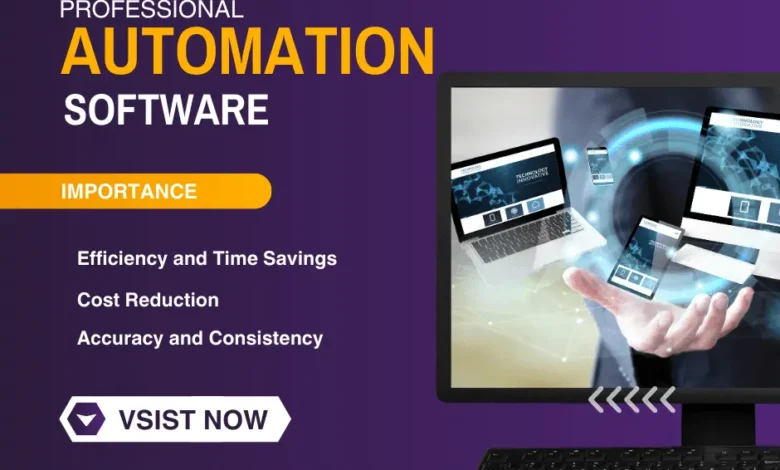What is Automation Software | Technical Files

Introduction to Automation Software
Automation software plays a pivotal role in streamlining processes and enhancing efficiency across various industries. Understanding its definition, purpose, and significance in modern business is crucial.
Definition and Purpose
Automation software refers to a set of tools and technologies designed to perform tasks without human intervention. Its primary purpose is to increase efficiency, reduce errors, and optimize workflows in business processes.
Importance in Modern Business
The growing complexity of business operations demands the adoption of automation software. Its role in improving productivity and ensuring precision has become indispensable in the contemporary corporate landscape.
Types of Automation Software
Exploring the diverse categories of automation software sheds light on their specific applications and functionalities.
1. Robotic Process Automation (RPA)
RPA involves the use of robots or bots to automate rule-based tasks, enhancing accuracy and speed in data-driven processes.
2. Business Process Automation (BPA)
BPA focuses on automating complex business processes, ensuring seamless coordination between different departments.
3. IT Process Automation (ITPA)
ITPA streamlines IT-related tasks, reducing manual efforts in managing infrastructure, system configurations, and network operations.
4. Test Automation
Test automation is crucial for software development, automating the testing phase to identify bugs and enhance software quality.
Key Features of Automation Software
Understanding the core features of automation software helps businesses make informed decisions during the selection process.
1. Workflow Automation
Efficient workflow automation ensures smooth coordination between different tasks, improving overall process efficiency.
2. Integration Capabilities
The ability to seamlessly integrate with existing systems is a key feature, allowing for a cohesive and connected business environment.
3. Scalability
Scalability is vital for adapting automation solutions to the evolving needs of a growing business.
4. Customization Options
Customization options enable businesses to tailor automation software to their specific requirements, maximizing its effectiveness.
Benefits of Implementing Automation Software
Examining the tangible benefits reinforces the value of incorporating automation software into business operations.
1. Increased Efficiency
Automation enhances efficiency by minimizing manual interventions, reducing processing time, and boosting overall productivity.
2. Cost Savings
The automation of repetitive tasks leads to cost savings through reduced labour expenses and increased operational efficiency.
3. Error Reduction
Automation significantly reduces the risk of human errors, ensuring consistent and accurate outcomes.
4. Improved Accuracy
Automated processes contribute to higher accuracy levels, particularly in data-intensive tasks.
Common Industries Using Automation Software
Automation software finds applications across diverse industries, each reaping unique benefits.
1. Manufacturing
In the manufacturing sector, automation streamlines production processes, improving precision and minimizing downtime.
2. Finance
In finance, automation handles routine tasks such as data entry and transaction processing, reducing the risk of errors.
3. Healthcare
Automation software enhances efficiency in healthcare by managing patient records, appointment scheduling, and billing processes.
4. Marketing
Marketing benefits from automation in tasks like email campaigns, social media scheduling, and data analysis.
Challenges and Considerations
While automation brings numerous advantages, businesses must address potential challenges and considerations.
1. Integration Challenges
Integrating automation into existing systems may pose challenges, requiring careful planning and execution.
2. Security Concerns
Automation introduces new security considerations, necessitating robust measures to safeguard sensitive data.
3. Employee Resistance
Employees may resist automation due to fear of job displacement or unfamiliarity with new technologies.
4. Initial Setup Costs
Implementing software automation engineer requires an initial investment, which may pose challenges for some businesses.
Choosing the Right Automation Software
Selecting the most suitable automation software involves a thorough evaluation of various factors.
1. Assessing Business Needs
Understanding specific business needs is crucial for selecting automation solutions that align with organizational goals.
2. Compatibility with Existing Systems
Ensuring compatibility with existing systems prevents disruptions and facilitates a smooth integration process.
3. User-Friendly Interfaces
User-friendly interfaces enhance the adoption of automation software among employees with varying technical expertise.
4. Vendor Reputation
Choosing a reputable vendor ensures the reliability and support needed for successful automation implementation.
Real-life Use Cases
Examining real-life examples highlights the tangible benefits and success stories associated with automation.
1. Success Stories
Businesses that successfully implement automation share their experiences and the positive impact on their operations.
2. Examples of Improved Processes
Specific examples illustrate how automation improves processes, leading to increased efficiency and cost savings.
Future Trends in Automation Software
Exploring emerging trends in automation provides insights into the evolving landscape of this technology.
1. Artificial Intelligence Integration
The integration of artificial intelligence enhances the capabilities of automation, enabling more intelligent decision-making.
2. Cloud-Based Automation
The shift towards cloud-based automation offers greater flexibility, accessibility, and scalability for businesses.
3. Increased Focus on User Experience
Future automation trends emphasize enhancing user experiences, making the technology more intuitive and user-friendly.
How to Implement Automation Software Successfully?
Achieving successful implementation involves strategic planning, training, and a commitment to continuous improvement.
1. Planning and Strategy
Thorough planning and a well-defined strategy lay the foundation for successful automation implementation.
2. Employee Training
Providing comprehensive training ensures that employees can effectively use and adapt to automation tools.
3. Continuous Improvement
A commitment to continuous improvement allows businesses to refine and optimize their automated processes over time.
Comparison with Manual Processes
Evaluating the differences between automated and manual processes provides a comprehensive understanding of the technology’s impact.
1. Efficiency and Speed
Automation significantly outpaces manual processes in terms of efficiency and speed, leading to quicker task completion.
2. Error Rates
Comparing error rates demonstrates the reliability of automation in minimizing mistakes compared to manual operations.
3. Employee Satisfaction
Exploring employee satisfaction reveals the positive impact of automation on reducing mundane tasks and allowing employees to focus on more meaningful work.
Impact on Job Roles
Understanding how automation affects job roles addresses concerns about potential job displacement and the evolving nature of work.
1. Job Displacement Concerns
Acknowledging concerns about job displacement fosters a proactive approach to addressing employee fears.
2. New Skill Requirements
Automation introduces the need for new skill sets, emphasizing the importance of ongoing employee development.
3. Evolution of Job Roles
Exploring the evolution of job roles in the context of automation sheds light on the changing dynamics of the workforce.
Automation Software and Small Businesses
Considering the specific needs and challenges of small businesses highlights the relevance and adaptability of automation.
1. Affordability Considerations
Affordable automation solutions cater to the budget constraints of small enterprises, making the technology accessible.
2. Tailored Solutions for Small Enterprises
Customized automation solutions address the unique requirements of small businesses, ensuring optimal functionality.
Ethical Considerations in Automation
Examining ethical considerations associated with automation prompts a thoughtful approach to its implementation.
1. Privacy Concerns
Addressing privacy concerns ensures that automated processes respect and protect sensitive data.
- Decision-Making Algorithms
Understanding the ethical implications of decision-making algorithms prompts responsible and transparent use.
3. Social Implications
Exploring the social implications of automation encourages a balanced approach that considers its impact on society.
Conclusion
In summary, compliance automation software is a transformative force in modern business, offering numerous benefits and addressing various challenges. As technology continues to evolve, businesses must adapt, ensuring ethical use and successful implementation for a more efficient and competitive future.
FAQs about Automation Software
Q: Is automation software suitable for all types of businesses?
A: Automation software can be tailored to suit various business sizes and industries. Assessing specific needs is crucial for successful implementation.
Q: How does automation impact job roles?
A: Automation may lead to job displacement in certain areas but also creates new opportunities, emphasizing the need for evolving skill sets.
Q: What are the key considerations when choosing automation software?
A: Assessing business needs, compatibility with existing systems, user-friendly interfaces, and vendor reputation are essential factors to consider.
Q: How can small businesses benefit from automation?
A: Affordable and tailored automation solutions cater to the unique needs of small enterprises, improving efficiency and competitiveness.
Q: What are the future trends in automation software?
A: Trends include the integration of artificial intelligence, cloud-based automation, and an increased focus on enhancing user experiences.
Visit the pi123 website to learn more about it.
Samsclub provides a one-stop shopping experience, offering a wide range of products at affordable prices. With its membership benefits and convenient online platform, customers can easily access quality goods and save both time and money. Whether you’re stocking up for your home or business, Samsclub is the go-to destination for all your shopping needs.



